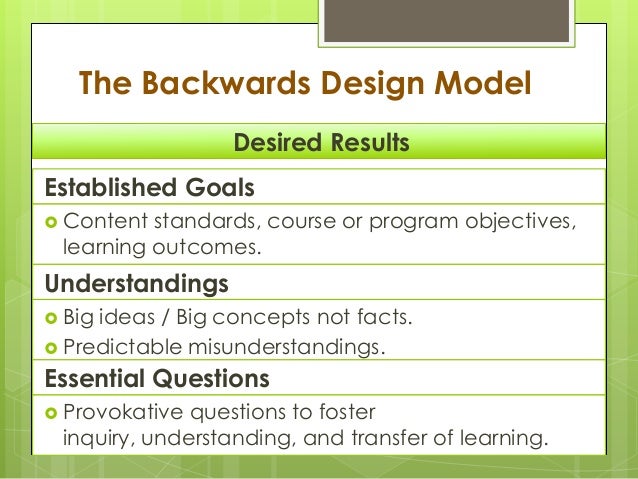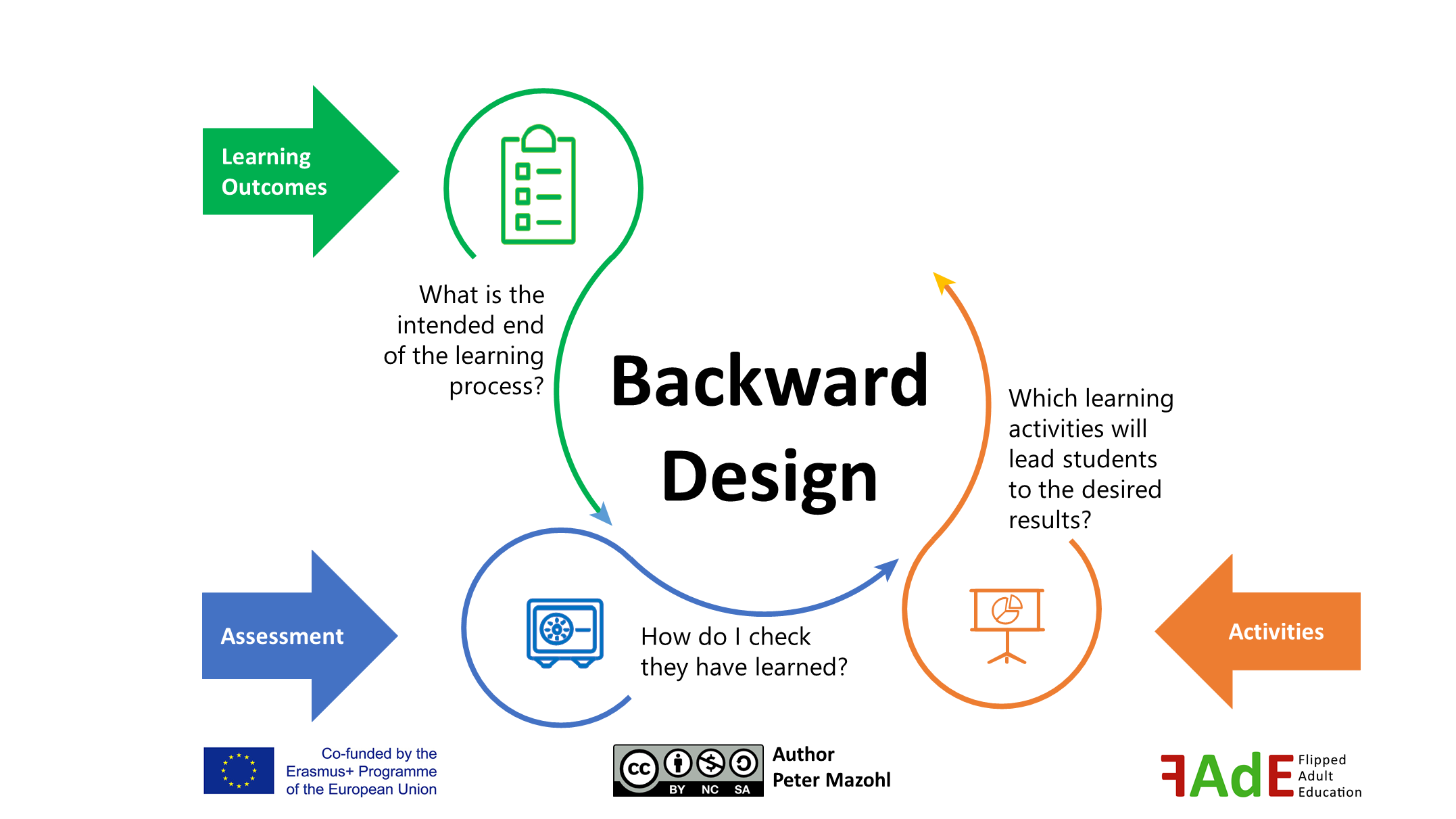Table Of Content

Nor does it ask them to “demonstrate knowledge” of how the whole system works. The standard wants students to develop a model and use it to describe the system. As educational paradigms continue to evolve, frameworks like Backward Design will likely undergo revisions and adaptations. Current trends in educational technology, personalized learning, and inclusive education all offer exciting avenues for integrating and evolving the principles of Backward Design.

Backwards Design Lesson Planning Template
Understanding how it compares to other frameworks helps educators make more informed choices about which approach to use in different teaching and learning contexts. At the same time, the other disadvantage of traditional lesson planning is that the process ignores the learner’s needs and role throughout the curriculum design process. Given this context on the traditional design process, backwards design is a much more practical and effective framework to help course creators design an engaging learning experience that makes an impact for the learners and their business. Backward design in a lesson plan means starting with the end objective, such as student-focused learning goals, and designing your assessments and learning materials afterward to ensure your students achieve those objectives. In a standard content-oriented approach to course design, the design process begins by identifying course content. From there, the instructor plans lectures, activities, and assignments to help students engage with that content.
For Educators
Working backwards to design a new user experience for Virtual Engineering Workbenches on AWS Amazon Web ... - AWS Blog
Working backwards to design a new user experience for Virtual Engineering Workbenches on AWS Amazon Web ....
Posted: Fri, 28 Jul 2023 07:00:00 GMT [source]
Predictably, some fell behind in the book like they did with all assigned reading. The key question is whether a one-size-fits-all approach can adequately cater to a classroom that is increasingly diverse in terms of learning styles, physical abilities, and cultural backgrounds. Educational scholars like Alfie Kohn have raised concerns that an approach like Backward Design, which starts with outcomes and assessments, might place too much emphasis on testing and grading. By acknowledging these theories and the scholars who contributed to them, we not only appreciate the intellectual roots of Backward Design but also understand its strong academic underpinnings. These theories collectively validate why Backward Design is more than a passing trend; it's a research-based, effective approach to education.
Psychology Resources
Let’s take a look at an example to illustrate the difference between a unit planned the traditional, topic-driven way, and the same unit planned with backward design. Curriculum theorist Jay McTighe, another co-creator of Backward Design, highlights how the approach can be adapted for different subjects, age groups, and educational settings. This adaptability makes it a popular choice for a wide range of educational contexts, from K-12 to higher education and corporate training. According to these critics, the structured, step-by-step nature of Backward Design could potentially stifle spontaneity and limit opportunities for exploratory learning. This could be particularly problematic in subjects like the arts, where creative exploration is key.
I. Identify the desired outcomes
Pursuant to the Backward Design model, desired results of instruction might be based upon national, state and local standards. This model prioritizes knowledge and focuses on what is most important for students to understand and achieve. Arguably, if design begins with the end in mind, instruction is more likely to clearly focus on the identified desired results[3].
Once you're comfortable with the approach, you can expand to more complex planning projects. Scholars in the field of special education, such as Thomas Hehir, question whether the Backward Design framework is flexible enough to accommodate learners with diverse needs. Issues around accessibility, differentiated instruction, and cultural responsiveness come to the fore. While these challenges and criticisms provide a more nuanced view of Backward Design, they don’t necessarily invalidate its effectiveness. Many educators find ways to adapt the approach to suit different learning environments and needs. Even outside the traditional educational environment, Backward Design has its place.
Contents
Ohio State historyLong before Wiggins and McTighe popularized backward design, Ralph Tyler was working with fellow faculty at The Ohio State University to improve data gathered from assessments. As early as his 1934 article, “Some Findings from Studies in the Field of College Biology,” Tyler details how he helped faculty sketch out the ideas of needs analysis, backward design, and setting behavioral objectives. In Understanding by Design, Wiggins and McTighe reference Tyler as the originator of behavioral objectives (2005, p. 20). If we assume that a large portion of a student’s grade is based on the test, then students are not being measured on their achievement of that standard.
How ANU Crawford School of Public Policy is not just surviving, but thriving - Study International
How ANU Crawford School of Public Policy is not just surviving, but thriving.
Posted: Sat, 08 Jan 2022 08:55:16 GMT [source]
Teaching methods will include direct instruction, inductive methods, cooperative learning, and group activities. When you create your course learning goals, you describe how you want students to change internally as a result of taking your course. Learning goals broadly state what students should know or care about by the end of a course or curriculum.
Time-Consuming Planning Phase
I mean, even though I loved the book, my students’ response to it was mostly lukewarm. Maybe it was the connections I was able to make to the stuff students dealt with on a day-to-day basis. I taught that book a few times, and even though I looked forward to it every time, I always finished the unit a little unsatisfied. By following these practical tips, educators can take meaningful steps towards successfully implementing Backward Design. The transition may come with its challenges, but the potential benefits for both teachers and students are substantial.
Information that fits within this question is the lowest priority content information that will be mentioned in the lesson, unit, or course. The older version (version 1.0) can also be downloaded at the Jay McTighe site previously mentioned, as well as other resources relevant to Understanding by Design. Wiggins and McTighe and other scholars have presented several arguments in favor of a backward design process.
However, Grant Wiggins and Jay McTighe argue that this framework is flawed, because its emphasis on teaching methods is misplaced. With Backward Design’s focus on the desired result (for example, preparing a clear, well-written case brief), instruction can be tailored to support this desired product. An integration of “backwards planning” unit design with the “two-step” lesson planning framework – This article takes a look at the process of backwards planning in a detailed case study of a math class. Unfortunately, this results in tests or assessments that don’t always reflect what the students did or learned. We’ve all experienced an unfortunate class or two where the test didn’t seem to reflect anything we had learned in lessons or course materials up until that point.

No comments:
Post a Comment